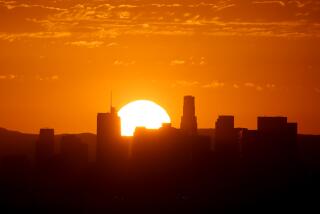California to match U.S. unemployment rate by 2017, UCLA economists predict
California’s unemployment rate is expected to gradually fall until it matches the national rate in 2017, according to economists from the UCLA Anderson Forecast.
The decrease will be driven by improvement in the construction and automotive industries, and by increased business investment and consumer demand, the economists predict.
The state’s jobless rate, which fell to 6.3% in April, will average 6.2% this year, then 5.2% next year before reaching 5% a year later, according to the quarterly report.
But the forecast contains caveats. Recent economic expansion has come paired with “an unusually large spike in the number of long-term unemployed” that appears to be linked to the decline in manufacturing and movements in the finance, legal and professional services sectors, said economist Jerry Nickelsburg.
Many of those are mid- to late-career baby boomers, who “do not have too many potential years left to recoup the cost obtaining new or enhanced skills,” Nickelsburg said.
“This puts them in a position where their current skills, rusting from years of disuse, have not been in high-enough demand to bring them back to work,” he said.
Combined with a burst of automation in the workplace, technology “has eliminated jobs that no amount of stimulus would bring back,” Nickelsburg said.
Barring immigration, employers may find themselves without a large pool of labor from which to recruit after mid-2016, he said.
The UCLA report singled out the high-tech industry in Southern California as lagging behind other leading tech centers. Economist William Yu noting that although the industry is developing fast nationwide, “Los Angeles is not among the top leaders in terms of patents, capital or salary.”
The region does, however, host a number of small businesses that together constitute a sizable information sector, Yu said. Further boosting Los Angeles’ cachet as a high-tech hub would attract better-paying jobs — key for residents in an area known for its high cost of living, Yu said.
Nationwide, economic growth lagged for the second straight year following stormy weather early in the year. Still, UCLA economists anticipate that GDP will reach a 3% growth rate by the third quarter — a pace that will remain through the end of next year.
The construction industry will be robust because of job gains, higher household formations, interest rates that remain low and looser mortgage underwriting standards, said economist David Shulman. Housing starts are forecast to increase to 1.16 million this year from 1 million last year, followed by 1.37 million starts next year.
Military spending, which has declined for four years, will tick up in response to increasing global tensions, he said.
And although consumers so far have taken advantage of lower gasoline prices — a roughly $150-billion annualized reduction — largely by paying down debts or buffering their savings accounts, economists foresee an eventual boost in spending.
“Needless to say, this behavior is not in accordance with the historical economics playbook,” Shulman said.
Twitter: @tiffhsulatimes







